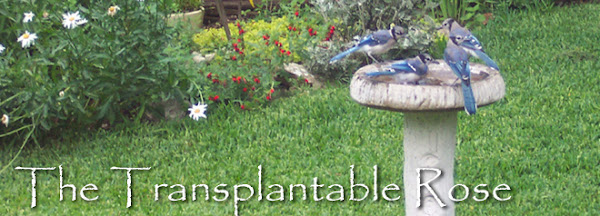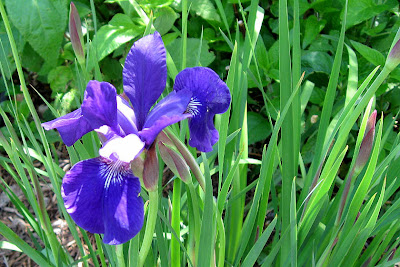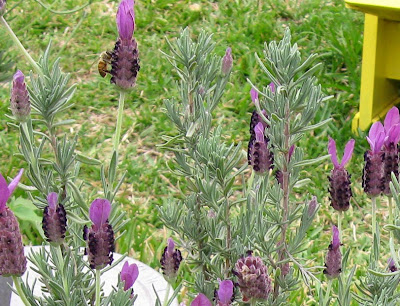I really liked the idea, and decided to copy Laura and make my own Tree Inventory post. After subtracting the area covered by driveway, hardscape & house from my quarter acre lot the remaining plantable area is pretty small... how hard could it be to count the trees on 1/8 of an acre?

"This should be a cinch," I thought. "All I have to do is take the tree names from my plant spreadsheet."
But it wasn't that that simple. The first problem was deciding what counted as a tree. Are hollies trees or shrubs? Are boxwoods shrubs? Where are the lines?
What about small baby trees in growing-on containers? Do I count trees that are brought into the garage or house in cold weather?
The second problem was that my spreadsheet was not complete. I'd made a note of every tiny plant brought home from Barton Springs Nursery and the Natural Gardener, but had never entered some of the large boring plants already growing here in 2004 when we bought this house. (I'm talking about you, Photinia.)
Categories seemed to be the answer.
For this list, a baby tree in a container is still a tree and trees kept permanently in containers are still trees, but they'll have their own category. I considered calling this Texas Palmetto a tree, but with a future height of only 5 to 6-ft, decided to leave it off the list.

A plant that wants to be a tree but can be kept to shrub height by constant pruning counts as a tree on the list. Neglect to prune a Ligustrum hedge or a Red Tip Photinia hedge and you'll end up with a forest of Ligustrum and Photinia trees.
If a treelike plant has the potential to be 7 or 8 feet tall it counts as a tree. For example, my Barbados Cherries have been pretty wimpy, but I've seen them look like small trees in the gardens of friends.
The trees and treelike shrubs that were already growing here when we moved in will have a separate category.
GROUP 1 -Trees that were here when we moved in that are still alive :
Arizona ash (1 very large)
Pecan, unknown variety (2 very large)

Live Oaks (2 medium large)
Yaupon holly (1 lovely, muli-trunked tree, about 15-ft tall)
Crepe myrtle, the common hot pink ( 6 in sizes from 7-ft to 20-ft)
Holly - some kind of Chinese holly (1 allowed to be a 12-ft tree, 1 pruned repeatedly to 5-ft)
Nandina (3 kept at 6-ft)
Red tip Photinia (3 kept under 10-ft)
GROUP 2 - Trees that were planted by us:
Loquat tree (3 trees, one large, one medium, one about 4-ft tall, all from seedlings)

The largest loquat is in the photo above, with Bay Laurel in container left, larger Southern Wax Myrtle in ground right
Magnolia 'Little Gem' (1 about 12-ft tall)
Sweet Olive (3. The oldest is very established and kept to 12-ft tall. Two younger plants are under 5-ft.)
Texas redbud (1, about 10-ft tall)
'Forest Pansy' redbud (1, about 10-ft tall)
Vitex /Chaste tree (1, kept to 10-ft tall, from a seedling)
Magnolia figo/ Banana shrub (1 about 8-ft tall)

In the photo above, the Banana shrub is at left next to the bench, center is a young Texas Mountain Laurel, then a camellia, then the tall, burgundy-leaved Loropetalum/Chinese Witch Hazel
Cenizo/Texas sage (1, kept to 8-ft, grown from a seedling)
Beautyberry AKA French mulberry (1, kept to about 7-ft tall)
Evergreen sumac (1, barely 5-ft tall after 7 years in the ground)
Barbados cherry trees (usually frozen back, one tree about 6-ft, another about 4-ft)
Crepe Myrtle 'Acoma' blooms white (2 trees, called semi-dwarf, kept to abt 12-ft in height)
Crepe Myrtle 'Catawba' blooms purple (2 young trees, under 5-ft.)

Crepe Myrtle labeled 'Muskogee', supposed to bloom lavender (1 young tree, abt 6-ft tall)
Crepe Myrtle 'Zuni' blooms orchid pink (1 young tree, under 9-ft)
Meyer's Improved Lemon (1 tree, when not winter-killed, pruned to about 9-ft tall

Loropetalum/Chinese Witch hazel (2 - the one in photo with Magnolia Figo is about 9-ft tall, the other is a young plant about 2-ft tall.)
Pineapple guava (1 about 6-ft tall)

The Pineapple Guava has reached the top of the privacy fence - in the background is one of the Live Oak trees.
Rose 'Mutabilis' (1 in ground, kept to 8-ft by diligent pruning)
Texas Mountain Laurel (4 plants. Two about 6-ft, one about 5-ft, one about 2-ft)

This is the only one of my 4 Texas Mountain Laurels that has ever bloomed.
Satsuma orange 'Miho' (1 young tree abt 3-ft tall)
Southern Wax Myrtle (1, about 5-6 ft)
Mexican Buckeye (1 baby tree in the ground, maybe 2 and 1/2 ft tall)
GROUP 3- Trees planted by us, presently growing in containers:
Oleander (1, very large container, kept to 10-ft in height.)
Rose 'Mutabilis' (1 about 6-ft tall)
Bay Laurel (1 about 5-ft tall)
Southern Wax Myrtle (1 abt 4-ft tall)

Dwarf Pomegranate (2 plants, one under 2-ft, one about 7-ft tall)
Pineapple guava (1 about 5-ft tall)
Montezuma cypress (1 baby tree)
Thai lime trees (2 small trees, both under 3-ft, one in garage, one outside)
Willow, corkscrew (1 under 5-ft kept in container, grown from a cutting)
Meyer's Improved Lemon, (1 small tree bought in March 2006 - blooming in the breakfast room right now)

Whether or not this list is interesting to you readers, it sure is useful for me as a garden record... Thanks for the idea, Laura!


















































